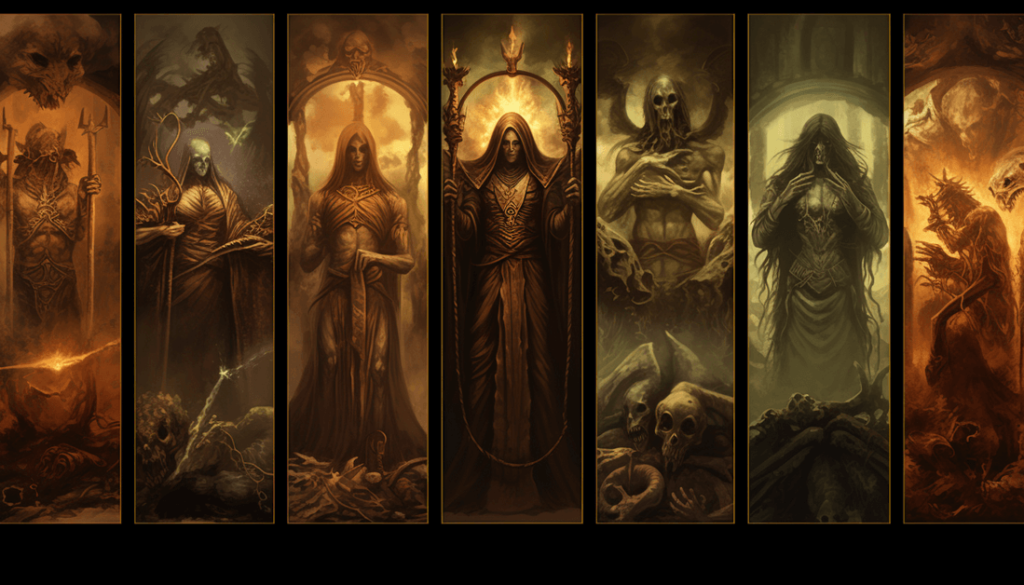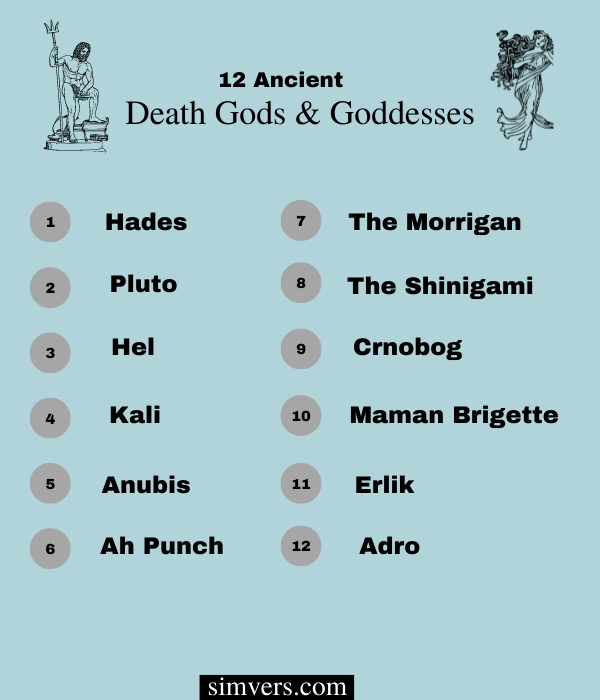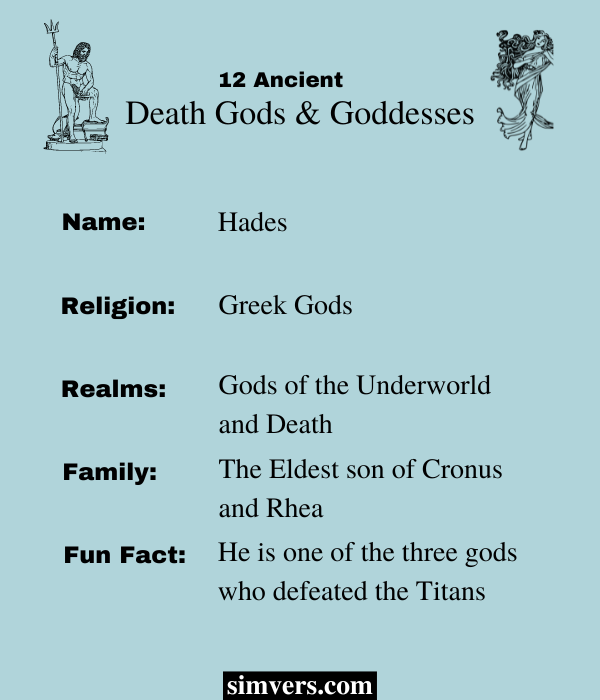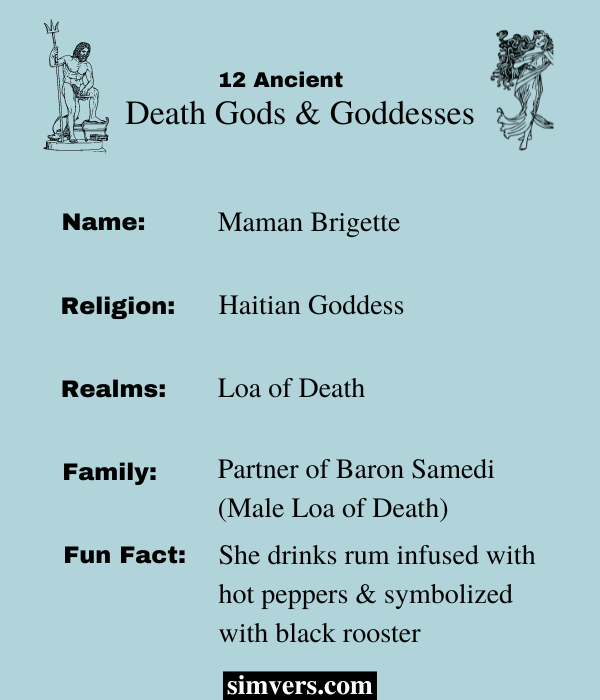
The ancient gods and goddesses of death, destruction, and the underworld were a varied lot. Some were fearsome deities who delighted in slaying mortals, while others were more benign and took pity on those who suffered.
Some were stunningly gorgeous and fair, while others were hideous or misshapen. But there was one thing that all of them had in common: each represented a different facet of death that we must confront at some point in our lives.
Some gods and goddesses are kind and forgiving, while others are angry and cruel. However, where people go in the afterlife depends on how they act in this world.
Read on to learn more about these ancient gods and goddesses. This article will cover the myths and legends of the ancient gods and goddesses of death, destruction, and the underworld.
From Anubis to Crnobog, we’ll look at some of the most popular gods in this category. Enjoy yourself!
What Were the Functions of the Gods and Goddesses of the Underworld?
The Gods and goddesses of the underworld were responsible for many different things. They helped people communicate with the dead, believed to live in the underworld.
They also had control over life and death and could send dreams or visions to humans. The gods also served as intermediaries between humans and other gods. They thought that they lived in caves or trees near lakes or rivers.
Some gods judged the dead, ensuring they sent the good souls to paradise. In other cultures, they believed that the underworld was where all souls went after death and where they lived until they were reincarnated.
Also, some gods were embodiments of chaos and destruction. They could bring famine, diseases, and natural disasters. Some cultures believed these gods needed to be appeased with sacrifices or rituals to keep them happy and prevent bad things from happening.

MORE:
- Are Adam And Eve In Heaven Or Hell
- Are There Any Black Amish?
- Autism-Related Anger
- Black Bead Bracelet
- Bible about Circumcision
The Twelve Gods and Goddess Of Death
1. Hades (Greek God of Death & Underworld)
The story of how Hades and his brothers, Poseidon and Zeus, divided the universe between each other is an interesting one. After defeating their father, Cronus, they drew lots to see who would rule which part of the world. Poseidon got control over the seas and oceans, and Zeus controlled the sky.
Finally, Hades got control over everything below ground. This included people living on Earth and those who had passed away by that time.
As the Lord of the Underworld, Hades ruled over the dead and could decide whether he would allow them to enter his realm. In some versions of the story, the Greeks considered him a cruel ruler who enjoyed torturing people who had died in pain. However, other versions paint him as more of an impartial judge who just did his job with no feelings.
Hades sits on his ebony throne and decides whether the souls deserve to go into the Elysian Fields. Some stories tell how Hades would often send death spirits called Furies to torment those who had been evil in life.
The Furies were three sisters with snakes for hair and blood dripping from their eyes. They would fly around and torment people with their sharp claws. The ancient Greeks revered Hades as one of their most important gods. They believed he watched over the dead and was not one you could mess with.

2. Pluto (the Roman God of Death)
The Romans had a special place for Pluto, their god of the underworld. The Romans believed Pluto was not just the god of death but also the god of wealth. They thought Pluto watched over all the precious metals and jewels found underground.
This is a significant distinction between the Roman and Greek gods of death. The Greeks did not associate wealth with death, and Hades, the god of the underworld, was not considered a fit guardian of riches.
Pluto was mighty for the Romans, and he was one you did not want to mess with. The Romans believed they sent those who broke their laws and were sentenced to death to Pluto’s kingdom, where they would suffer for eternity.
The origin of the deity of Pluto is quite complicated. Early Romans worshipped Plouton, the Dīs Pater. When the Romans conquered Greece, they adopted many gods and syncretized them with their existing deities. Plouton was one of these gods whose name and function they changed.
The Romans identified Pluto with Hades, the god of the underworld (a dark place where the gods sent dead people). Pluto’s wife is known as Proserpina.
Depictions of Pluto show him as an old man with a beard and holding a scepter. The Romans often depicted him with Cerberus, the three-headed dog that guards the gates of Hades. This is quite interesting, as the dog is not present in Roman mythology.
3. Hel (the Norse God of Death)
The Vikings were a hardy bunch. They worked hard and lived poorly, facing many difficulties in their daily lives. The land was harsh; the winters were cold and long, and there were many threats from within their borders and from other people.
So, it’s no surprise that the Norse gods were powerful beings who could do incredible things. One of these gods was Hel (also known as Hela or Hella), the goddess of death and ruler over the underworld.
Born of the trickster god, Loki, and the giantess, Angrboda, Hel is one of the agents of destruction in the Norse pantheon. She is not a god of death but rather a grim reaper-like figure who collects souls and brings them to her homeland, Niflheim (the dark world).
The Norse depicted Hel as a cruel, harsh, and indifferent deity. She lives in a cold, dark realm surrounded by a pack of black wolves. The Norse often depicted her as a beautiful woman with long, flowing hair, but her face is pale, and her eyes are empty; she has no feelings or emotions.
4. Kali (the Hindu God of Death)
We have another goddess on our list. While Hel is more like a symbol of death and the underworld, Kali is a goddess responsible for human death. She is the Hindu goddess of destruction, creation, and time. Her skin is blue, and she has four arms; each carries a weapon she uses to kill her enemies.
Kali means “She Who Is Death” or “She Who Is Black” in Sanskrit, but she is not evil like Hel (the Norse goddess). She’s considered one of the most important deities in Hinduism.
Kali wields her swords and has few clothes, and she’s often depicted as a mother figure. She is the wife of Shiva, and together they are the gods of creation and destruction.
Kali, the Hindu God of Death, has many legends linked with her. According to legend, she put an end to a monster named Raktabija. Kali drank all of his blood so that he wouldn’t multiply from one drop of blood into many monsters.
There is another (possibly greater) form of Kali called Mahakali. Mahakali is the supreme goddess who represents the divine creative force that created the universe. Her worshippers often depict her as having ten heads, arms, and legs.
5. Anubis (the Egyptian God of the Underworld)
Powerful and imposing, Anubis, or Anpu, the Egyptian god of mummification and embalming, guided the dead into the underworld. Anubis was depicted as a man with the black head of an animal (usually a jackal or wolf) and a knife in each hand.
He was also shown wearing a white robe and holding an ankh (a symbol of life). Depending on the particular Egyptian pantheon, Anubis was either the son of Osiris (another god of death) and Nephthys (the sky goddess) or the son of Ra (the sun god) and Hathor (another sky goddess).
Anubis was often shown as a protector of graves and cemeteries in paintings, sculptures, or hieroglyphics. The Egyptians often prayed to Anubis to help them on their journey into the afterlife.
The Egyptian Book of the Dead, written by priests, said Anubis would “preside over any judgment of a soul” and decide how he should judge it. People usually wanted favor with Anubis to ensure he judged them favorably.
The Egyptians believed Anubis weighed the dead person’s heart against a feather to test their morality during life. They could enter paradise if their hearts were lighter than his feathers.
6. Ah Puch (the Mayan God of Death)
Ah Puch ruled over Metnal and was one of the most important Mayan gods. He was associated with death and disease and was believed to be responsible for causing illness.
The Mayans prayed to Ah Puch to help them cure their illnesses. Some Mayan priests would become so good at curing diseases that they were considered “miracle workers” by their communities.
Ah Puch has a skeletal body with a necklace made of human eyes and a large nose. He is often depicted wearing a skirt made of strips of human skin, and many Mayans believed that he smelled like decomposing flesh.
As the Mayans believed life and death were part of a cycle, Ah Puch was also associated with childbirth. Ah Puch punished his victims by burning them with a torch, and then he would take their souls to the underworld. The Mayans believed that by praying to Ah Puch, they could help their loved ones who had died find their way through the afterlife.
He also appears as Cizin, a man who smokes a cigar and wears an enormous hat. The Mayans also called him “the Stinking One” because they believed he smelled like a dead body.
7. The Morrigan (the Celtic God of Death)
The Morrigan is a Celtic god of death who is most often depicted as a beautiful woman with three faces. She was also known as “the Phantom Queen” and “the Raven-Haired.”
In some legends, she’s described as an old hag who would turn into a crow or raven when she flew over battlefields. The Morrigan was associated with war and prophecy, which led to her being portrayed as both good and evil.
She is also the goddess of battle, strife, war, and fertility. The Morrigan is seen as the Washer at the Ford. The Washer at the Ford is an old Irish myth about a woman who washes the bloody clothing of those who have been killed in battle. She is sometimes seen as a goddess or nymph who protects warriors from death on the battlefield.
The Celts believed she was present at each person’s death, preparing them for the afterlife. This is why she is often seen as a goddess of death and rebirth. The Morrigan is the triune goddess who represents “the three Morrígna,” the three sisters with several roles, from goddesses of war to fertility goddesses and guardians at the crossroads.
8. The Shinigami (Japanese Gods of Death)
Unlike the other entities on our list, the Shinigami do not have a specific gender. The Japanese gods of death are considered spirits or ghosts, taking on different roles depending on the story being told.
In some tales, they are depicted as malevolent creatures who enjoy killing humans for sport. But in others, they are seen as benevolent beings who help people pass into the afterlife by performing noble acts in life so that they can welcome their souls into paradise when they die.
The second version is more widely accepted, as the Japanese believe these spirits are responsible for sending people into a state of eternal sleep and protecting them from being murdered.
The Shinigami have various powers, including transforming into other creatures, such as animals or insects. They can also shapeshift into human form and often appear as young men wearing black robes.
Some old Japanese tales also mention the Shinigami possessing people and taking over their bodies. These were usually the spirits of dead people who wanted to take their revenge on the living. The Japanese also believed they could control humans with their minds and make them do things against their will.
9. Crnobog (Slavic God of Death)
The Slavs were a fearsome and ferocious tribe of people who lived in Eastern Europe long ago. They were known for their bloody and violent rituals and worshiped many pagan gods. One of these was Crnobog, who was the Slavic god of death.
This deity was strongly associated with the color black, which is why so many ancient Slavic artifacts adorn this color. They also know him as Czernobog or Cert. The Slavs saw him as an equal to Belobog, the Slavic god of light. They often portrayed him as a dark-skinned man with a black beard and eyes. His symbol was the raven, which the Slavs associated with death.
They believed their soul would get caught in the body and turn into a bird when someone died. This is where they got the idea that ravens were evil creatures that stole souls from bodies.
Czernobog was responsible for punishing those who broke the laws of nature as the god of winter, famine, chaos, and darkness. When the Slavs were invaded by other tribes and had to fight them off, they believed that Czernobog was helping their enemies. They prayed to him in hopes of getting rid of the invaders.
10. Maman Brigette (the Haitian Goddess of Death)
The Haitian people have a religion and belief system that mixes Roman Catholicism and African religions. They have a goddess called Maman Brigette, the Haitian version of the goddess Brigid.
She is the goddess of death, agriculture, healing, and fire. Like many other gods in different cultures, she has many aspects to her personality.
Maman Brigette is the consort of Baron Samedi and is often represented as a giant snake. This deity is not to be angered because of her powers; she can be pretty dangerous. She is known as the “Lady of the Cemeteries” and has many followers in Haiti. The Haitian people often consider Maman Brigette a motherly figure who cares for all people, especially those facing death.
The goddess is an impartial judge who will decide each person’s fate. She is also a goddess of fertility and can be prayed to for help conceiving children or healing infertility. Maman Brigette is often depicted with snakes on her headdress, but you can also find her wearing flowers, bones, or skulls.

11. Erlik (the Siberian God of Death)
According to the Uighur people of eastern Kazakhstan, Erlik was a feared god who lived in the underworld and ruled over all spirits. They also knew him as Eralig or Erlik Khan, which meant “the black ruler.” He is said to have been an evil spirit responsible for death and disease.
Being the first creature of the god, Ulgan or Tengri, Erlik was very powerful. He was very proud and wanted to be the ruler of all the gods. When he tried to usurp Tengri’s throne, Ulgan threw him into the underworld.
Some stories say that he was involved in the world’s creation and helped to form humans from clay. After killing the messenger god, Maidere, Erlik was banished to the underworld. There, he ruled over the spirits of the dead and their kingdom. He also had control over diseases, evil spirits, and demons.
His worshippers often represent him with the totem of an ugly bear, and he has nine sons and daughters who are spirits of disease or evil. Erlik was a paramount god in Tengriism and was often worshipped alongside Ulgan. He is also the supreme deity in Mongolian shamanism, where he is regarded as being responsible for illness and misfortune.
12. Adro (the Lugbara God of Death)
Most African deities are various aspects of the Supreme Being or creator god. Adro isn’t different. He is the personification of death and the underworld. The Lugbara people often represent him as a skeleton in Lugbara mythology, and like many other African gods, he can walk between the worlds of the living and the dead.
He can also appear as a snake or a tall, translucent human with a large head and a stick. Adro is the only god with direct communication with humans and can be summoned by drumming, songs, and rituals. The Lugbara tribe also knows him as the “creator of all evil.”
This god often appears in the dreams of dying people and takes them to the underworld. It is believed that this god has the power to decide whether someone lives or dies.
The Lugbara people believed that the guardian spirits of the dead were Adro’s children, and they were responsible for watching over the living. These spirits lived in trees or caves and were often feared by the living.
Conclusion
Death is an integral part of every culture. The way people think about death can be very different from one society to another. This belief shows itself in the various gods and goddesses of death and how people think about what happens after death. Some deities are considered kind and merciful, while others are seen as violent and vengeful. In many cultures, people believed that their actions in life would determine what happened after death. The gods would reward those who lived good lives with a pleasant afterlife; those who did evil things would be punished.
MORE:
- Disciple and apostle
- Do You Have To Be Baptized To Go To Heaven?
- Gayatri Mantra
- Greek Gods & Goddesses
- Release Rage
